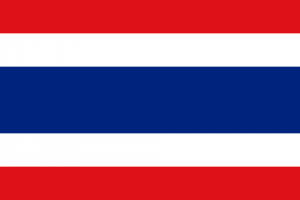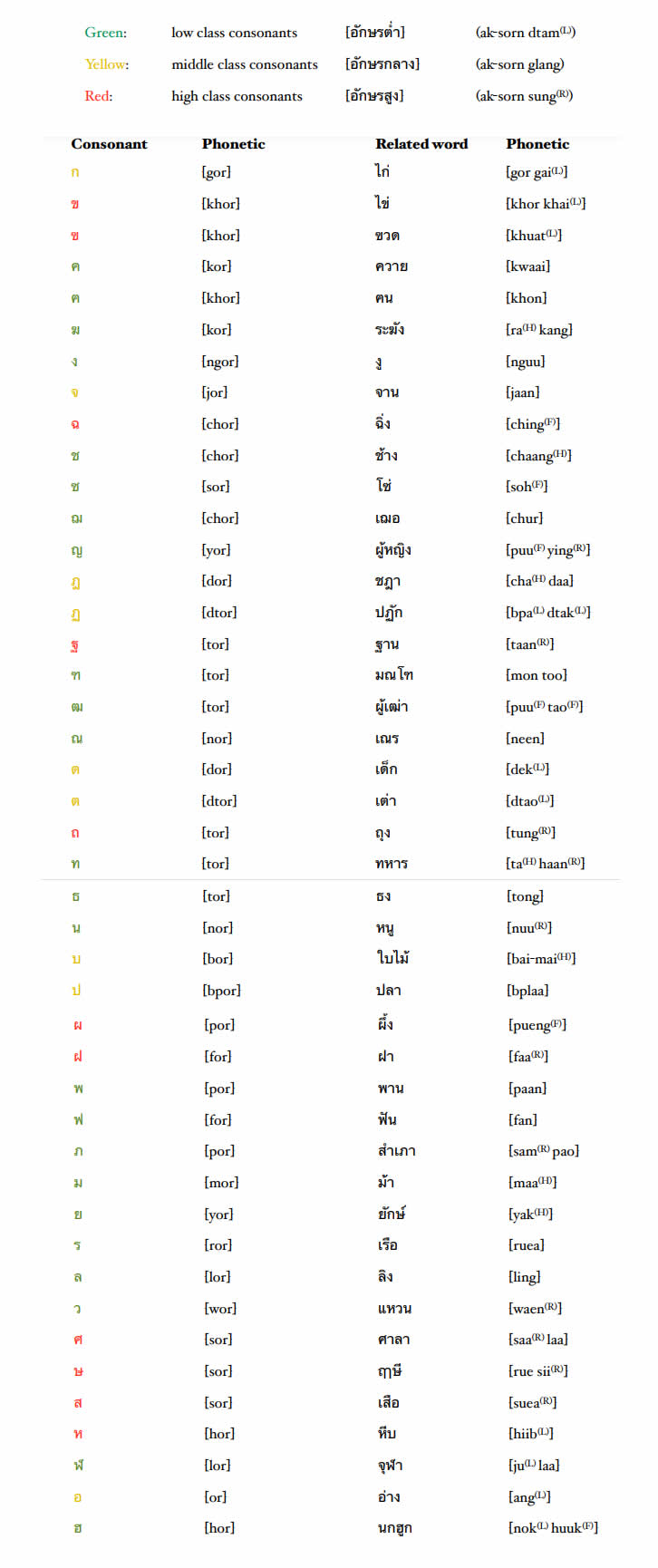Language/Thai/Pronunciation/Alphabet-and-Pronunciation
Thai, Central Thai (historically Siamese; Thai: ภาษาไทย), is the national and official language of Thailand.
Here is how to pronounce each letter of the Thai alphabet.
TONES & SOUND
If the tone is wrong, or you put the pressure at the wrong place, the word can get a whole different meaning. Therefore, pay close attention to this chapter. This is just a guide line on how to help you on the right track, you will only progress if you do your homework. A key is: talk slow and clearly. There is no need to speed it up in order to “sound like a native”, because you won’t. Take it easy, take your time and get the pronunciation right. A little tip; put in some earplugs and speak out loud. This will help you to hear your voice more clearly so you can stop your mistakes and know where you need to improve. To record your own voice and play it over and over again is also a very good technique. In the beginning you will be embarrassed to hear your own Thai, but get over that because it will help you improve a lot. Then you can listen to your voice recordings everywhere; in the sky train, the car or just in your room.
I am not a fan of the phonetic alphabet, as a matter of fact I detest it. Who invented that ก should be written a K when it makes a G sound? and ต written as a T when it makes a DT sound? As you progress with the Thai alphabet you will, like me and many others, start to question it. I agree and understand that there are some sounds that you can’t write with the Roman alphabet, but your teacher can teach you the sounds, so don’t go too hard about learning the phonetic alphabet as it is a waste of time. Learn the basics and then forget about it. (L) behind the phonetic word meaning a low tone, (H) meaning a high tone, (F) meaning a falling tone, (R) meaning a rising tone and if there is no symbol then it’s a middle tone.
Consonants
| Letter | Name | Name in Latin | IPA | |
|---|---|---|---|---|
| Initial | Final | |||
| ก | ก ไก่ | ko kai | [k] | [k̚] |
| ข | ข ไข่ | kho khai | [kʰ] | [k̚] |
| ฃ | ฃ ขวด | kho khuat | [kʰ] | [k̚] |
| ค | ค ควาย | kho khwai | [kʰ] | [k̚] |
| ฅ | ฅ คน | kho khon | [kʰ] | [k̚] |
| ฆ | ฆ ระฆัง | kho ra-khang | [kʰ] | [k̚] |
| ง | ง งู | ngo ngu | [ŋ] | [ŋ] |
| จ | จ จาน | cho chan | [tɕ] | [t̚] |
| ฉ | ฉ ฉิ่ง | cho ching | [tɕʰ] | – |
| ช | ช ช้าง | cho chang | [tɕʰ] | [t̚] |
| ซ | ซ โซ่ | so so | [s] | [t̚] |
| ฌ | ฌ เฌอ | cho choe | [tɕʰ] | – |
| ญ | ญ หญิง | yo ying | [j] | [n] |
| ฎ | ฎ ชฎา | do cha-da | [d] | [t̚] |
| ฏ | ฏ ปฏัก | to pa-tak | [t] | [t̚] |
| ฐ | ฐ ฐาน | tho than | [tʰ] | [t̚] |
| ฑ | ฑ มณโฑ | tho montho | [tʰ] | [t̚] |
| ฒ | ฒ ผู้เฒ่า | tho phu-thao | [tʰ] | [t̚] |
| ณ | ณ เณร | no nen | [n] | [n] |
| ด | ด เด็ก | do dek | [d] | [t̚] |
| ต | ต เต่า | to tao | [t] | [t̚] |
| ถ | ถ ถุง | tho thung | [tʰ] | [t̚] |
| ท | ท ทหาร | tho thahan | [tʰ] | [t̚] |
| ธ | ธ ธง | tho thong | [tʰ] | [t̚] |
| น | น หนู | no nu | [n] | [n] |
| บ | บ ใบไม้ | bo baimai | [b] | [p̚] |
| ป | ป ปลา | po pla | [p] | [p̚] |
| ผ | ผ ผึ้ง | pho phueng | [pʰ] | – |
| ฝ | ฝ ฝา | fo fa | [f] | – |
| พ | พ พาน | pho phan | [pʰ] | [p̚] |
| ฟ | ฟ ฟัน | fo fan | [f] | [p̚] |
| ภ | ภ สำเภา | pho sam-phao | [pʰ] | [p̚] |
| ม | ม ม้า | mo ma | [m] | [m] |
| ย | ย ยักษ์ | yo yak | [j] | – or [n] |
| ร | ร เรือ | ro ruea | [r] | [n] |
| ล | ล ลิง | lo ling | [l] | [n] |
| ว | ว แหวน | wo waen | [w] | – |
| ศ | ศ ศาลา | so sala | [s] | [t̚] |
| ษ | ษ ฤๅษี | so rue-si | [s] | [t̚] |
| ส | ส เสือ | so suea | [s] | [t̚] |
| ห | ห หีบ | ho hip | [h] | – |
| ฬ | ฬ จุฬา | lo chu-la | [l] | [n] |
| อ | อ อ่าง | o ang | [ʔ] | – |
| ฮ | ฮ นกฮูก | ho nok-huk | [h] | – |
=Low, Middle and High class Consonants
Vowels
| Diacritic | Name | IPA |
|---|---|---|
| ◌ะ | a | a |
| ◌ั | a | a |
| ◌า | a | aː |
| ◌ิ | i | i |
| ◌ี | i | iː |
| ◌ึ | ue | ɯ |
| ◌ื | ue | ɯː |
| ◌ือ | ue | ɯː |
| ◌ุ | u | u |
| ◌ู | u | uː |
| เ◌ะ | e | e |
| เ◌็ | e | e |
| เ◌ | e | eː |
| แ◌ะ | ae | ɛ |
| แ◌็ | ae | ɛ |
| แ◌ | ae | ɛː |
| โ◌ะ | o | o |
| โ◌ | o | oː |
| เ◌าะ | o | ɔ |
| ◌็อ | o | ɔ |
| ◌อ | o | ɔː |
| ◌็ | o | ɔː |
| เ◌อะ | oe | ɤ |
| เ◌อ | oe | ɤː |
| เ◌ิ | oe | ɤː |


